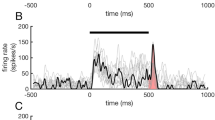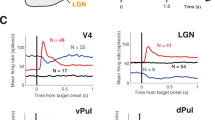Abstract
The thalamic reticular nucleus (TRN) is thought to function in the attentional searchlight. We analyzed the detection of deviant acoustic stimuli by TRN neurons and the consequences of deviance detection on the TRN target, the medial geniculate body (MGB) of the rat. TRN neurons responded more strongly to pure-tone stimuli presented as deviant stimuli (low appearance probability) than those presented as standard stimuli (high probability) (deviance-detection index = 0.321). MGB neurons also showed deviance detection in this procedure, albeit to a smaller extent (deviance-detection index = 0.154). TRN neuron deviance detection either enhanced (14 neurons) or suppressed (27 neurons) MGB neuronal responses to a probe stimulus. Both effects were neutralized by inactivation of the auditory TRN. Deviance modulation effects were cross-modal. Deviance detection probably causes TRN neurons to transiently deactivate surrounding TRN neurons in response to a fresh stimulus, altering auditory thalamus responses and inducing attention shift.
This is a preview of subscription content, access via your institution
Access options
Subscribe to this journal
Receive 12 print issues and online access
$209.00 per year
only $17.42 per issue
Buy this article
- Purchase on Springer Link
- Instant access to full article PDF
Prices may be subject to local taxes which are calculated during checkout







Similar content being viewed by others
References
Jones, E.G. Some aspects of the organization of the thalamic reticular complex. J. Comp. Neurol. 162, 285–308 (1975).
Steriade, M., Jones, E.G. & McCormick, D.A. Thalamus: Organization and Function (Elsevier Science, Oxford, 1997).
Yen, C.T., Conley, M., Hendry, S.H. & Jones, E.G. The morphology of physiologically identified GABAergic neurons in the somatic sensory part of the thalamic reticular nucleus in the cat. J. Neurosci. 5, 2254–2268 (1985).
Houser, C.R., Vaughn, J.E., Barber, R.P. & Roberts, E. GABA neurons are the major cell type of the nucleus reticularis thalami. Brain Res. 200, 341–354 (1980).
Deschênes, M., Madariaga-Domich, A. & Steriade, M. Dendrodendritic synapses in the cat reticularis thalami nucleus: a structural basis for thalamic spindle synchronization. Brain Res. 334, 165–168 (1985).
Steriade, M. & Deschênes, M. The thalamus as a neuronal oscillator. Brain Res. 320, 1–63 (1984).
Bal, T. & McCormick, D.A. Mechanisms of oscillatory activity in guinea-pig nucleus reticularis thalami in vitro: a mammalian pacemaker. J. Physiol. (Lond.) 468, 669–691 (1993).
McCormick, D.A. & Prince, D.A. Acetylcholine induces burst firing in thalamic reticular neurones by activating a potassium conductance. Nature 319, 402–405 (1986).
Crick, F. Function of the thalamic reticular complex: the searchlight hypothesis. Proc. Natl. Acad. Sci. USA 81, 4586–4590 (1984).
Llinás, R. & Paré, D. in Thalamus (eds. Steriade M., Jones E.G. & McCormick D.A.) 501–516 (Plenum, New York, 1997).
Shosaku, A. & Sumitomo, I. Auditory neurons in the rat thalamic reticular nucleus. Exp. Brain Res. 49, 432–442 (1983).
Simm, G.M., de Ribaupierre, F., de Ribaupierre, Y. & Rouiller, E.M. Discharge properties of single units in auditory part of reticular nucleus of thalamus in cat. J. Neurophysiol. 63, 1010–1021 (1990).
Malone, B.J. & Semple, M.N. Effects of auditory stimulus context on the representation of frequency in the gerbil inferior colliculus. J. Neurophysiol. 86, 1113–1130 (2001).
Pérez-González, D., Malmierca, M.S. & Covey, E. Novelty detector neurons in the mammalian auditory midbrain. Eur. J. Neurosci. 22, 2879–2885 (2005).
Yu, X.-J., Xu, X.-X., Chen, X., He, S.-G. & He, J. Slow recovery from excitation of thalamic reticular nucleus neurons. J. Neurophysiol. 101, 980–987 (2009).
Ulanovsky, N., Las, L. & Nelken, I. Processing of low-probability sounds by cortical neurons. Nat. Neurosci. 6, 391–398 (2003).
Zhang, Z. et al. Corticofugal projection inhibits the auditory thalamus through the thalamic reticular nucleus. J. Neurophysiol. 99, 2938–2945 (2008).
He, J., Yu, Y.Q., Xiong, Y., Hashikawa, T. & Chan, Y.S. Modulatory effect of cortical activation on the lemniscal auditory thalamus of the Guinea pig. J. Neurophysiol. 88, 1040–1050 (2002).
Landisman, C.E. et al. Electrical synapses in the thalamic reticular nucleus. J. Neurosci. 22, 1002–1009 (2002).
Long, M.A., Landisman, C.E. & Connors, B.W. Small clusters of electrically coupled neurons generate synchronous rhythms in the thalamic reticular nucleus. J. Neurosci. 24, 341–349 (2004).
Warren, R.A., Agmon, A. & Jones, E.G. Oscillatory synaptic interactions between ventroposterior and reticular neurons in mouse thalamus in vitro. J. Neurophysiol. 72, 1993–2003 (1994).
Zikopoulos, B. & Barbas, H. Prefrontal projections to the thalamic reticular nucleus form a unique circuit for attentional mechanisms. J. Neurosci. 26, 7348–7361 (2006).
Knight, R. Contribution of human hippocampal region to novelty detection. Nature 383, 256–259 (1996).
Tiitinen, H., May, P., Reinikainen, K. & Náátánen, R. Attentive novelty detection in humans is governed by pre-attentive sensory memory. Nature 372, 90–92 (1994).
Carpenter, G.A. & Grossberg, S. Normal and amnesic learning, recognition and memory by a neural model of cortico-hippocampal interactions. Trends Neurosci. 16, 131–137 (1993).
Mühlau, M. et al. Structural brain changes in tinnitus. Cereb. Cortex 16, 1283–1288 (2006).
Llinás, R.R. & Paré, D. Of dreaming and wakefulness. Neuroscience 44, 521–535 (1991).
Crabtree, J.W. & Isaac, J.T. New intrathalamic pathways allowing modality-related and cross-modality switching in the dorsal thalamus. J. Neurosci. 22, 8754–8761 (2002).
Jahnsen, H. & Llinás, R. Electrophysiological properties of guinea-pig thalamic neurones: an in vitro study. J. Physiol. (Lond.) 349, 205–226 (1984).
Jahnsen, H. & Llinás, R. Ionic basis for the electro-responsiveness and oscillatory properties of guinea-pig thalamic neurones in vitro. J. Physiol. (Lond.) 349, 227–247 (1984).
Sherman, S.M. A wake-up call from the thalamus. Nat. Neurosci. 4, 344–346 (2001).
Guillery, R.W. & Sherman, S.M. Thalamic relay functions and their role in corticocortical communication: generalizations from the visual system. Neuron 33, 163–175 (2002).
He, J. On and off pathways segregated at the auditory thalamus of the guinea pig. J. Neurosci. 21, 8672–8679 (2001).
Guo, Y.P. et al. Corticothalamic synchronization leads to c-fos expression in the auditory thalamus. Proc. Natl. Acad. Sci. USA 104, 11802–11807 (2007).
Xiong, Y., Yu, Y.Q., Chan, Y.S. & He, J. Effects of cortical stimulation on auditory-responsive thalamic neurones in anaesthetized guinea pigs. J. Physiol. (Lond.) 560, 207–217 (2004).
Paxinos, G. & Watson, C. The Rat Brain in Stereotaxic Coordinates (Elsevier Academic Press, Amsterdam, 2005).
Acknowledgements
The authors thank A. Palmer and M. Wallace for their critical readings and comments. This work was supported by the Natural Science Foundation of China (Overseas Cooperation Fund) and the Hong Kong Grants Council (PolyU 5412/06M).
Author information
Authors and Affiliations
Contributions
X.-J.Y., S.H. and J.H. designed the experiments. X.-J.Y. and X.-X.X. performed the experiments. X.-J.Y. and J.H. analyzed the results and wrote the manuscript.
Corresponding authors
Supplementary information
Supplementary Text and Figures
Supplementary Figures 1–5 (PDF 1645 kb)
Rights and permissions
About this article
Cite this article
Yu, XJ., Xu, XX., He, S. et al. Change detection by thalamic reticular neurons. Nat Neurosci 12, 1165–1170 (2009). https://doi.org/10.1038/nn.2373
Received:
Accepted:
Published:
Issue Date:
DOI: https://doi.org/10.1038/nn.2373
This article is cited by
-
Novelty detection in an auditory oddball task on freely moving rats
Communications Biology (2023)
-
Cross-Modal Interaction and Integration Through Stimulus-Specific Adaptation in the Thalamic Reticular Nucleus of Rats
Neuroscience Bulletin (2022)
-
Involvement of the thalamic reticular nucleus in prepulse inhibition of acoustic startle
Translational Psychiatry (2021)
-
The effect of NMDA-R antagonist, MK-801, on neuronal mismatch along the rat auditory thalamocortical pathway
Scientific Reports (2020)
-
The rostroventral part of the thalamic reticular nucleus modulates fear extinction
Nature Communications (2019)



